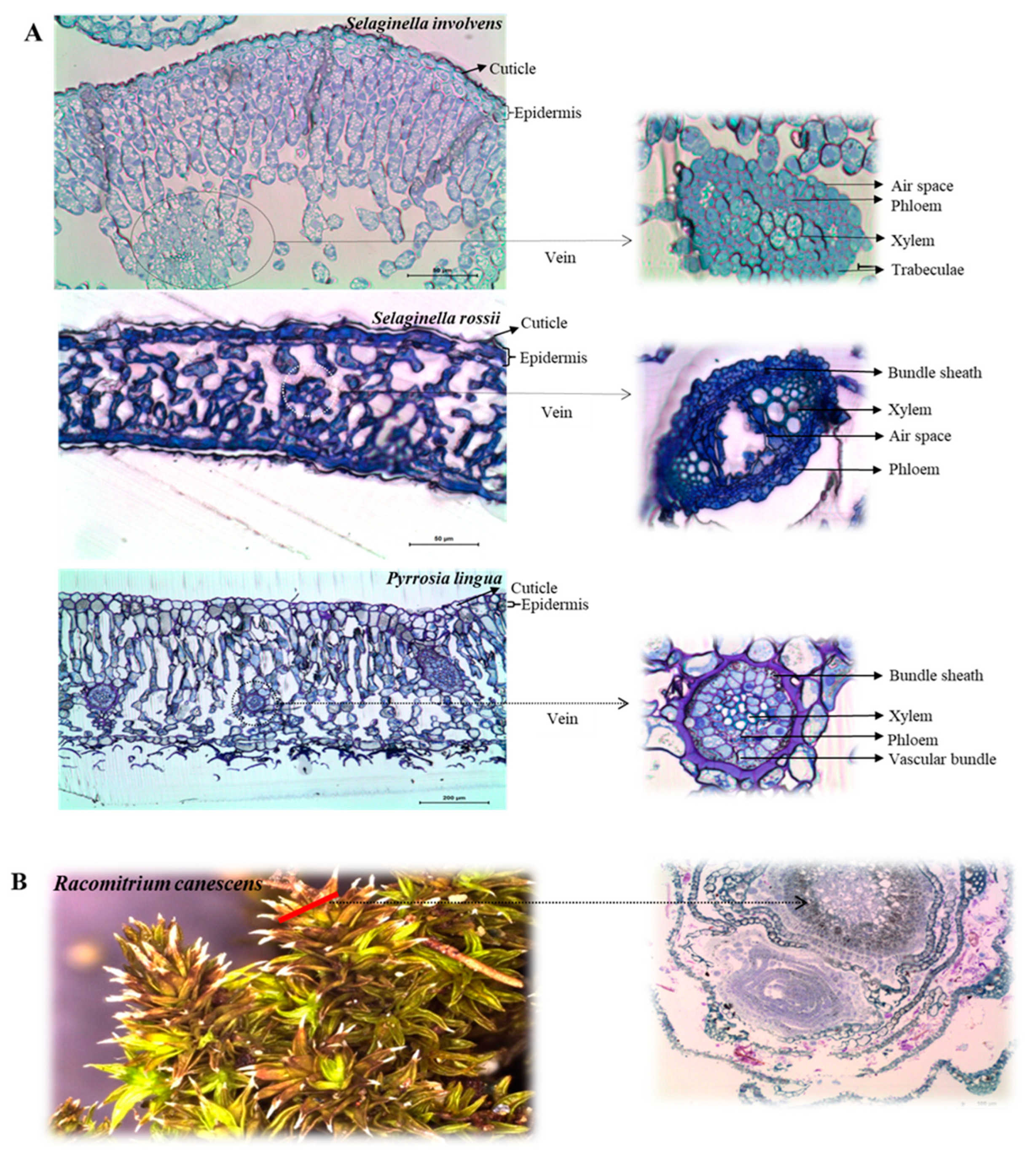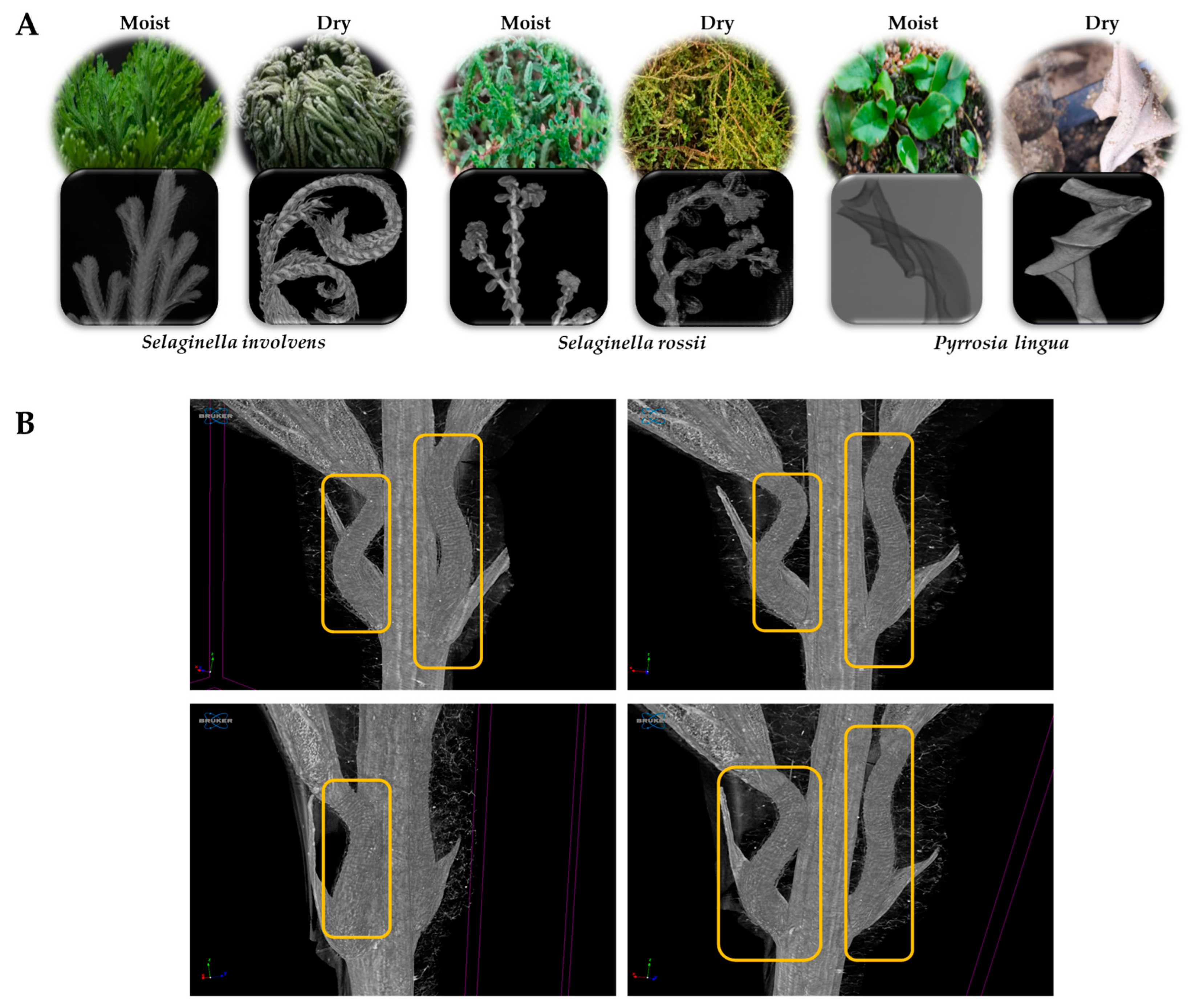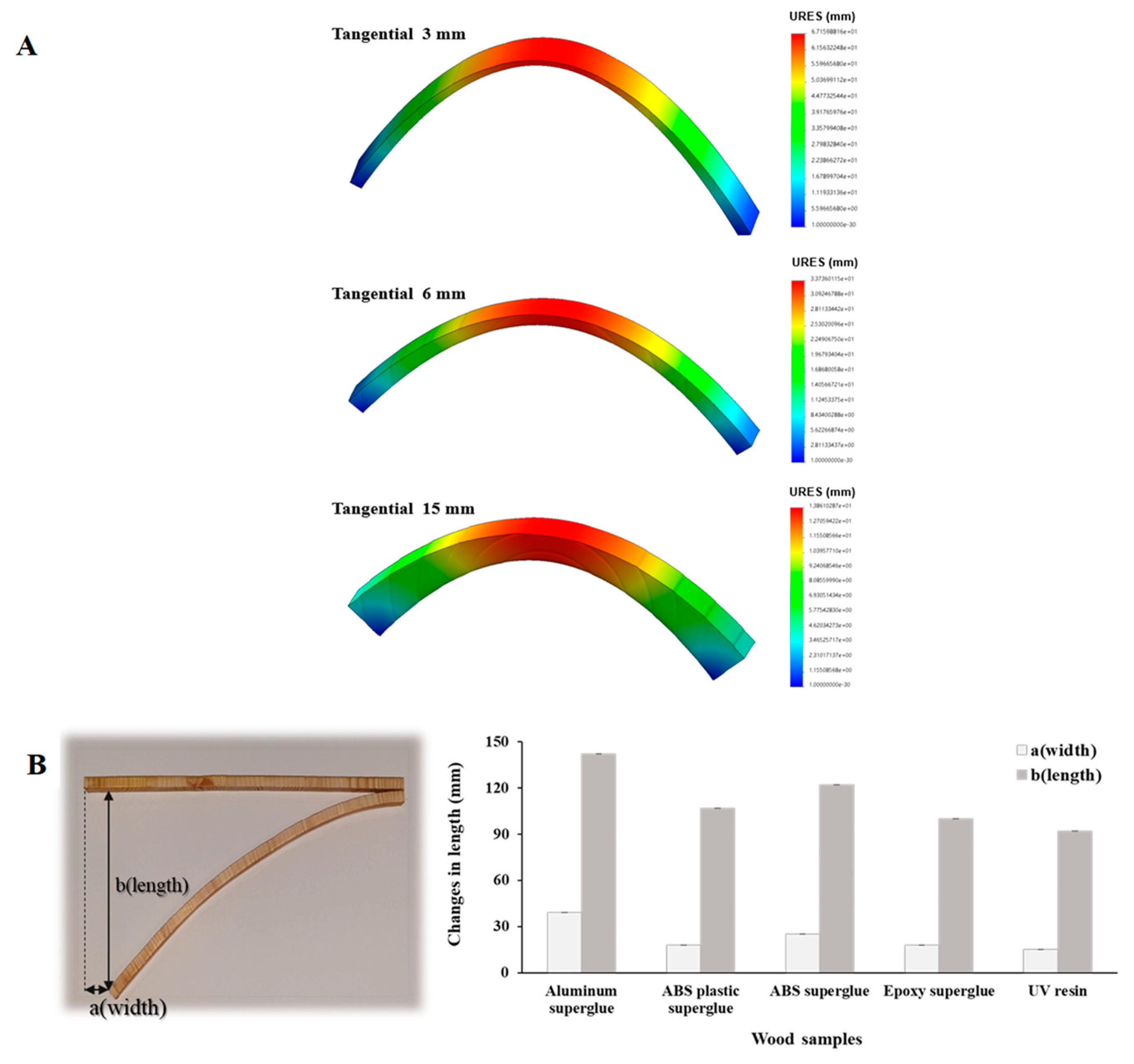Exploring the Mechanisms of Humidity Responsiveness in Plants and Their Potential Applications
Abstract
:1. Introduction
2. Materials and Methods
2.1. Plant Materials and Pretreatments
2.2. Light Microscopy Analysis
2.3. Three-Dimensional X-ray Imaging System Analysis
2.4. Field Emission Scanning Electron Microscopy (FE-SEM) Analysis
2.5. Micro-Computational Tomography (CT) Analysis
2.6. Biomimetic Application
3. Results and Discussion
3.1. Internal Structure of Humidity-Sensing Plants
3.2. Leaf Morphological Changes
3.3. Biomimetic Application
4. Conclusions
Author Contributions
Funding
Institutional Review Board Statement
Informed Consent Statement
Data Availability Statement
Acknowledgments
Conflicts of Interest
References
- Baluška, F.; Mancuso, S. Plant cognition and behavior: From environmental awareness to synaptic circuits navigating root apices. In Memory and Learning in Plants. Signaling and Communication in Plants; Baluska, F., Gagliano, M., Witzany, G., Eds.; Springer: Cham, Switzerland, 2018; pp. 51–77. [Google Scholar]
- Sopory, S.; Kaul, T. Sentient nature of plants: Memory and awareness. In Sensory Biology of Plants; Sopory, S., Ed.; Springer: Singapore, 2019; pp. 621–642. [Google Scholar]
- Segundo-Ortin, M.; Calvo, P. Consciousness and cognition in plants. WIREs Cogn. Sci. 2022, 13, e1578. [Google Scholar] [CrossRef]
- Elbaum, R.; Gorb, S.; Fratzl, P. Structures in the cell wall that enable hygroscopic movement of wheat awns. J. Struct. Biol. 2008, 164, 101–107. [Google Scholar] [CrossRef]
- Banks, J.A.; Nishiyama, T.; Hasebe, M.; Bowman, J.L.; Gribskov, M.; dePamphilis, C.; Albert, V.A.; Aono, N.; Aoyama, T.; Ambrose, B.A.; et al. The Selaginella genome identifies genetic changes associated with the evolution of vascular plants. Sci. Rep. 2011, 332, 960–963. [Google Scholar] [CrossRef]
- Abraham, Y.; Elbaum, R. Hygroscopic movements in Geraniaceae: The structural variations that are responsible for coiling or bending. New Phytol. 2013, 199, 584–594. [Google Scholar] [CrossRef]
- Harrington, M.J.; Razghandi, K.; Ditsch, F.; Guiducci, L.; Rueggeberg, M.; Dunlop, J.W.C.; Fratzl, P.; Neinhuis, C.; Burgert, I. Origami-like unfolding of hydro-actuated ice plant seed capsules. Nat. Commun. 2011, 2, 337. [Google Scholar] [CrossRef]
- Di Salvo, S. Advances in research for biomimetic materials. Adv. Mater. Res. 2018, 1149, 28–40. [Google Scholar]
- Zhang, Y.; Wu, L.; Wang, X.; Yu, J.; Ding, B. Super hygroscopic nanofibrous membrane-based moisture pump for solar-driven indoor dehumidification. Nat. Comm. 2020, 11, 3302. [Google Scholar] [CrossRef]
- Waughray, D. Fourth Industrial Revolution for the Earth Series. Harnessing the Fourth Industrial Revolution for Life on Land; World Economic Forum, The Platform for Accelerating the Circular Economy (PACE): Geneva, Switzerland, 2018. [Google Scholar]
- Ciulli, E. Tribology and industry: From the origins to 4.0. Front Mech. Eng. 2019, 5, 55. [Google Scholar] [CrossRef]
- Cleymand, F.; Rousseau, M.; Mano, J.F. Introducing biomimetic approaches to materials development and product design for engineering students. Bioinspir. Biomim. Nanobiomater. 2015, 4, 207–212. [Google Scholar] [CrossRef]
- Lim, C.W.; Park, I.; Yoon, B. Technology development tools in biomimetics utilizing TRIZ: Biomimetic-TRIZ matrix. In Proceedings of the 2015 Portland International Conference on Management of Engineering and Technology (PICMET), Portland, OR, USA, 2–6 August 2015; pp. 2307–2312. [Google Scholar]
- Rovalo, E.; McCardle, J. Performance based abstraction of biomimicry design principles using prototyping. Designs 2019, 3, 38. [Google Scholar] [CrossRef]
- Graeff, E.; Maranzana, N.; Aoussat, A. Biological practices and fields, missing pieces of the biomimetics’ methodological puzzle. Biomimetics 2020, 5, 62. [Google Scholar] [CrossRef]
- Dawson, C.; Vincent, J.F.V.; Rocca, A.-M. How pine cones open. Nature 1997, 390, 668. [Google Scholar] [CrossRef]
- Reyssat, E.; Mahadevan, L. Hygromorphs: From pine cones to biomimetic bilayers. J. R. Soc. Interface 2009, 6, 951–957. [Google Scholar] [CrossRef] [PubMed]
- Rafsanjani, A.; Brulé, V.; Western, T.; Pasini, D. Hydro-responsive curling of the resurrection plant Selaginella lepidophylla. Sci Rep. 2015, 5, 8064. [Google Scholar] [CrossRef] [PubMed]
- Uphof, J.C.T. Physiological anatomy of xerophytic Selaginellas. New Phytol. 1920, 19, 101–131. [Google Scholar] [CrossRef]
- Loreto, F.; Bagnoli, F.; Calfapietra, C.; Cafasso, D.; De Lillis, M.; Filibeck, G.; Fineschi, S.; Guidolotti, G.; Sramkó, G.; Tökölyi, J.; et al. Isoprenoid emission in hygrophyte and xerophyte European woody flora: Ecological and evolutionary implications. Glob. Ecol. Biogeogr. 2014, 23, 334–345. [Google Scholar] [CrossRef]
- Plancot, B.; Gügi, B.; Mollet, J.-C.; Loutelier-Bourhis, C.; Ramasandra Govind, S.; Lerouge, P.; Follet-Gueye, M.-L.; Vicré, M.; Alfonso, C.; Nguema-Ona, E.; et al. Desiccation tolerance in plants: Structural characterization of the cell wall hemicellulosic polysaccharides in three Selaginella species. Carbohydr. Polym. 2019, 208, 180–190. [Google Scholar] [CrossRef]
- Abe, T.; Hisama, M.; Tanimoto, S.; Shibayama, H.; Mihara, Y.; Nomura, M. Antioxidant effects and antimicrobial activites of phytoncide. Biocontrol Sci. 2008, 13, 23–27. [Google Scholar] [CrossRef]
- Erb, R.M.; Sander, J.S.; Grisch, R.; Studart, A.R. Self-shaping composites with programmable bioinspired microstructures. Nat. Commun. 2013, 4, 1712. [Google Scholar] [CrossRef]
- Barthlott, W.; Mail, M.; Bhushan, B.; Koch, K. Plant surfaces: Structures and functions for biomimetic innovations. Nano-Micro Lett. 2017, 9, 23. [Google Scholar] [CrossRef]
- Bi, H.; Kovalchuk, N.; Langridge, P.; Tricker, P.J.; Lopato, S.; Borisjuk, N. The impact of drought on wheat leaf cuticle properties. BMC Plant Biol. 2017, 17, 85. [Google Scholar] [CrossRef]
- Schulz, C.; Little, D.; Stevenson, D.; Bauer, D.; Moloney, C.; Stützel, T. An overview of the morphology, anatomy, and life cycle of a new model species: The lycophyte Selaginella apoda (L.) Spring. Int. J. Plant Sci. 2010, 171, 693–712. [Google Scholar] [CrossRef]
- Cosgrove, D.J. Catalysts of plant cell wall loosening. F1000Research 2016, 5, 119. [Google Scholar] [CrossRef]
- Čučaković, A.; Jovic, B.; Komnenov, M. Biomimetic geometry approach to generative design. Period. Polytech. Arch. 2016, 47, 70–74. [Google Scholar] [CrossRef]
- Kim, J.; Park, K. The design characteristics of nature-inspired buildings. Civ. Eng. Arch. 2018, 6, 88–107. [Google Scholar] [CrossRef]
- Backman, A.; Lindberg, H. Differences in wood material responses for radial and tangential direction as measured by dynamic mechanical thermal analysis. J. Mater. Sci. 2001, 36, 3777–3783. [Google Scholar] [CrossRef]
- Mascia, N.; Rocco Lahr, F. Remarks on orthotropic elastic models applied to wood. Mater. Res. 2006, 9, 301–310. [Google Scholar] [CrossRef]
- Borůvka, V.; Novák, D.; Šedivka, P. Comparison and analysis of radial and tangential bending of softwood and hardwood at static and dynamic loading. Forests 2020, 11, 896. [Google Scholar] [CrossRef]
- Rüggeberg, M.; Burgert, I. Bio-inspired wooden actuators for large scale applications. PLoS ONE 2015, 10, e0120718. [Google Scholar] [CrossRef] [PubMed]
- Peck, E.C. Bending Solid Wood to Form; Agriculture handbook no. 125; US Department of Agriculture: Washington, DC, USA, 1957.
- Ionov, L. Biomimetic hydrogel-based actuating systems. Adv. Funct. Mater. 2013, 23, 4555–4570. [Google Scholar] [CrossRef]






Disclaimer/Publisher’s Note: The statements, opinions and data contained in all publications are solely those of the individual author(s) and contributor(s) and not of MDPI and/or the editor(s). MDPI and/or the editor(s) disclaim responsibility for any injury to people or property resulting from any ideas, methods, instructions or products referred to in the content. |
© 2023 by the authors. Licensee MDPI, Basel, Switzerland. This article is an open access article distributed under the terms and conditions of the Creative Commons Attribution (CC BY) license (https://creativecommons.org/licenses/by/4.0/).
Share and Cite
Bae, H.; Kim, J. Exploring the Mechanisms of Humidity Responsiveness in Plants and Their Potential Applications. Appl. Sci. 2023, 13, 12797. https://doi.org/10.3390/app132312797
Bae H, Kim J. Exploring the Mechanisms of Humidity Responsiveness in Plants and Their Potential Applications. Applied Sciences. 2023; 13(23):12797. https://doi.org/10.3390/app132312797
Chicago/Turabian StyleBae, Haejin, and Jinhee Kim. 2023. "Exploring the Mechanisms of Humidity Responsiveness in Plants and Their Potential Applications" Applied Sciences 13, no. 23: 12797. https://doi.org/10.3390/app132312797
APA StyleBae, H., & Kim, J. (2023). Exploring the Mechanisms of Humidity Responsiveness in Plants and Their Potential Applications. Applied Sciences, 13(23), 12797. https://doi.org/10.3390/app132312797





